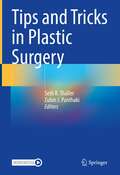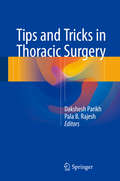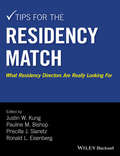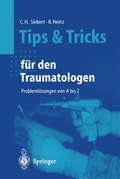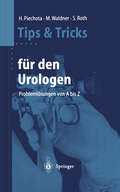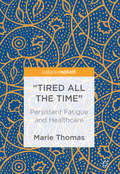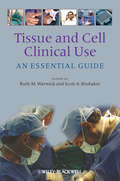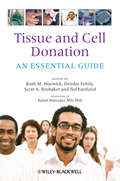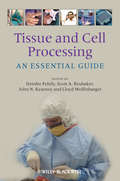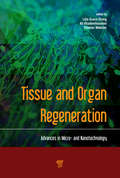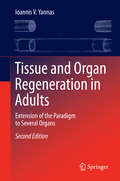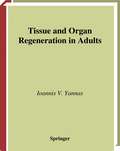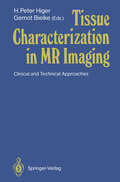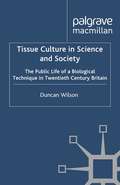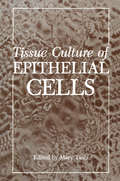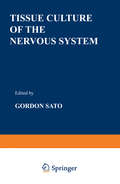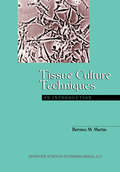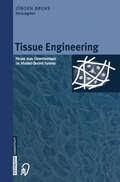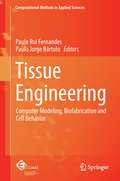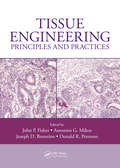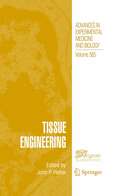- Table View
- List View
Tips and Tricks in Plastic Surgery
by Seth R. Thaller Zubin J. PanthakiThe book covers the most innovative, contemporary, and common plastic surgery procedures, and aims to improve both reconstructive and aesthetic surgical results while decreasing the incidence of complications. In doing so, patient satisfaction, quality of care, and safety are enhanced. The text provides a wealth of knowledge seeking to enhance results, reduce morbidity, and ensure patient satisfaction. The book consists of five parts, running the gamut of Aesthetic Surgery, Reconstructive Procedures, Pediatric and Craniomaxillofacial Surgery, Adjunctive Procedures, and finally Hand and Upper Extremity. Written by experts in the field, each chapter describes tips and tricks through clear technical details, medical illustrations and, in some chapters, detailed videos. Tips and Tricks in Plastic Surgery serves as a valuable resource for clinicians, professionals and practitioners, as well as medical students on rotation.
Tips and Tricks in Thoracic Surgery
by Dakshesh Parikh Pala B. RajeshThoracic surgery is a high-risk speciality and requires attention to detail. This book, compiled by expert surgeons from around the world, offers pearls of wisdom on how to improve the surgical outcome and how to reduce unnecessary complications. The book is designed so that it covers all common thoracic operations in both adults and children as well as dealing with much rarer indications. It includes a discussion on the complications of surgery and provides specific tips on how to avoid intra-operative and postoperative complications. Tips and Tricks in Thoracic Surgery is a fully illustrated, comprehensive text aimed at qualified and trainee thoracic surgeons.
Tips for the Residency Match: What Residency Directors Are Really Looking For
by Justin W. Kung Pauline M. Bishop Priscilla J. Slanetz Ronald L. EisenbergTips for the Residency Match is a unique guide for medical students applying for residency positions. Packed with hints, tips, and recommendations from both program directors and current residents, Tips for the Residency Match chronologically covers the key information required to excel during the residency application process - from résumé advice and preparing for the interview and beyond. Both insightful and practical, Tips for the Residency Match features a wide spectrum of medical specialties and an extra section for foreign graduates.Tips for the Residency Match is: Uniquely tailored to the needs of those applying for US residency positions Written by leading Residency Directors and current residents in the major specialties Offers unprecedented access to how departmental decisions about the Match are made Boasting expert advice and a wide scope, Tips for the Residency Match is the ideal companion for those applying for residency positions throughout the United States.
Tips for the Residency Match: What Residency Directors Are Really Looking For
by Justin W. Kung Pauline M. Bishop Priscilla J. Slanetz Ronald L. EisenbergTips for the Residency Match is a unique guide for medical students applying for residency positions. Packed with hints, tips, and recommendations from both program directors and current residents, Tips for the Residency Match chronologically covers the key information required to excel during the residency application process - from résumé advice and preparing for the interview and beyond. Both insightful and practical, Tips for the Residency Match features a wide spectrum of medical specialties and an extra section for foreign graduates.Tips for the Residency Match is: Uniquely tailored to the needs of those applying for US residency positions Written by leading Residency Directors and current residents in the major specialties Offers unprecedented access to how departmental decisions about the Match are made Boasting expert advice and a wide scope, Tips for the Residency Match is the ideal companion for those applying for residency positions throughout the United States.
Tips und Tricks für den Traumatologen: Problemlösungen von A bis Z (Tipps und Tricks)
by Christian H. Siebert Bruno C. HeinzDieses Buch befaßt sich mit zahlreichen Schwierigkeiten der Diagnostik und Therapie in der Unfallchirurgie und der traumatologischen Orthopädie, die in Klinik und Praxis auftreten können. In über 100 Tips und Tricks werden die Probleme geschildert und Lösungen oder Alternativen vorgeschlagen, die häufig besonders kostengünstig un patientenfreundlich sind. Die Beiträge sind alphabetisch geordnet und übersichtlich strukturiert, wodurch die einzelnen Stichworte schnell auffindbar und leicht nachvollziehbar sind. Fast alle Methoden und Techniken werden durch zahlreiche Abbildungen zusätzlich veranschaulicht. Dieses Buch ist jedem Unfallchirurgen, Sportmediziner und Orthopäden wärmstens zu empfehlen, es enthält aber auch für interessierte Studenten viele wertvolle Informationen, die über das Lehrbuchwissen hinausgehen.
Tips und Tricks für den Urologen: Problemlösungen von A bis Z (Tipps und Tricks)
by Hansjürgen Piechota Michael Waldner Stephan RothDie Autoren bieten praktische Lösungswege für die oft schwierigen Fragestellungen in der urologischen Diagnostik und Therapie. In der übersichtlichen Struktur finden Sie schnell kostengünstige und patientenfreundliche Lösungen und Alternativen. Zahlreiche anschauliche Abbildungen zu den Techniken und Methoden machen Ihnen die praktische Umsetzung leicht.
“Tired all the Time”: Persistent Fatigue and Healthcare
by Marie ThomasThis book explores the history, effects, diagnosis and treatment of chronic fatigue as well its significant links to other illnesses. Fatigue is a difficult symptom to accurately assess and quantify due to its subjective nature. Marie Thomas discusses the uncertainties and difficulties in its diagnosis as well as the broader effects of fatigue on quality of life. Fatigue is an increasingly reported problem in primary care, and one that is associated with other chronic conditions as a secondary symptom. Using several case studies, this book describes how in many cases, a patient’s primary condition can be managed; however General Practitioners are left unable to address the fatigue experienced, especially in older adults. Chapters consider the interventions that exist to manage fatigue – especially in the case of Chronic Fatigue Syndrome (CFS) – before highlighting the lack of strategies in primary care for dealing with the problem. In the final chapter Thomas discusses potential interventions and gives recommendations for future research regarding fatigue. This book will be of interest to academics and practitioners in healthcare and psychology, as well as to patient groups and those who care for individuals with fatigue.
“Tired all the Time”: Persistent Fatigue and Healthcare
by Marie ThomasThis book explores the history, effects, diagnosis and treatment of chronic fatigue as well its significant links to other illnesses. Fatigue is a difficult symptom to accurately assess and quantify due to its subjective nature. Marie Thomas discusses the uncertainties and difficulties in its diagnosis as well as the broader effects of fatigue on quality of life. Fatigue is an increasingly reported problem in primary care, and one that is associated with other chronic conditions as a secondary symptom. Using several case studies, this book describes how in many cases, a patient’s primary condition can be managed; however General Practitioners are left unable to address the fatigue experienced, especially in older adults. Chapters consider the interventions that exist to manage fatigue – especially in the case of Chronic Fatigue Syndrome (CFS) – before highlighting the lack of strategies in primary care for dealing with the problem. In the final chapter Thomas discusses potential interventions and gives recommendations for future research regarding fatigue. This book will be of interest to academics and practitioners in healthcare and psychology, as well as to patient groups and those who care for individuals with fatigue.
Tissue and Cell Clinical Use: An Essential Guide
by Ruth M. Warwick Scott A. BrubakerThis new book explores clinical information in the tissue transplantation field and acts as a comprehensive learning tool to comply with regulatory requirements. Broad in scope, coverage includes all the traditionally transplanted tissues and moves into more complex areas of tissue grafting and the assisted reproduction fields. This useful text focuses on the potential for disease transmission, ways to improve safety, and the role of the clinician in these safety aspects. The book starts off by describing non-surgical risks of using allografts and moves onto chapters devoted completely to tissue- or cell-specific issues relating to transplantation of the individual types of tissues or cells. Tissue and Cell Clinical Use: An Essential Guide is the final book in a series which covers all aspects of tissue banking, donation, processing, and transplantation. Each book in the series includes lists of learning points and case studies which consist of sample processing protocols, descriptions of where processing went wrong, sample risk assessments, or validation studies. This three book series covers all you need to know about tissue banking.
Tissue and Cell Clinical Use: An Essential Guide
by Ruth M. Warwick Scott A. BrubakerThis new book explores clinical information in the tissue transplantation field and acts as a comprehensive learning tool to comply with regulatory requirements. Broad in scope, coverage includes all the traditionally transplanted tissues and moves into more complex areas of tissue grafting and the assisted reproduction fields. This useful text focuses on the potential for disease transmission, ways to improve safety, and the role of the clinician in these safety aspects. The book starts off by describing non-surgical risks of using allografts and moves onto chapters devoted completely to tissue- or cell-specific issues relating to transplantation of the individual types of tissues or cells. Tissue and Cell Clinical Use: An Essential Guide is the final book in a series which covers all aspects of tissue banking, donation, processing, and transplantation. Each book in the series includes lists of learning points and case studies which consist of sample processing protocols, descriptions of where processing went wrong, sample risk assessments, or validation studies. This three book series covers all you need to know about tissue banking.
Tissue and Cell Donation: An Essential Guide
by Ruth M. Warwick Deirdre Fehily Scott A. Brubaker Ted Eastlund Rafael MatesanzThis is the guide to tissue and cell donation that you have been waiting for. Policies and practices reviewed using specific donor case histories as examples Multidisciplinary, multi-national team of editors and contributors, with expertise in ethics, consent, transplantation, microbiology and tissue and cell banking Provides a guide to easier and safer practice in referrals, tissue procurement, cord blood collection and decision making in general This unique book explores a range of issues related to the human impact of tissue and cell donation programmes around the world. It addresses the areas that are of key concern and have profound implications for the donors, recipients and healthcare professionals involved. Focusing on tissue, assisted reproduction and hematopoietic stem cells this book is essential reading for all those working in the field of human transplant donation and those who regulate this field.
Tissue and Cell Processing: An Essential Guide
by Deirdre Fehily Scott A. Brubaker John N. Kearney Lloyd WolfinbargerBy presenting the latest technological advances and growing national and international regulation, this new book explores state-of-the-art developments in the challenging field of tissue and cell processing. It provides a guide to easier and safer practice in operational principles of preservation, decontamination, and sterilization. Nearly half of the book is devoted completely to tissue- or cell-specific issues relating to processing. With lists of learning points and case studies which consist of sample processing protocols, descriptions of where processing went wrong, sample risk assessments, or validation studies, the authors help you find specific information fast.
Tissue and Cell Processing: An Essential Guide
by Deirdre Fehily Scott A. Brubaker John N. Kearney Lloyd WolfinbargerBy presenting the latest technological advances and growing national and international regulation, this new book explores state-of-the-art developments in the challenging field of tissue and cell processing. It provides a guide to easier and safer practice in operational principles of preservation, decontamination, and sterilization. Nearly half of the book is devoted completely to tissue- or cell-specific issues relating to processing. With lists of learning points and case studies which consist of sample processing protocols, descriptions of where processing went wrong, sample risk assessments, or validation studies, the authors help you find specific information fast.
Tissue and Organ Regeneration: Advances in Micro- and Nanotechnology
by Lijie Grace Zhang Ali Khademhosseini Thomas WebsterTissue engineering aims to develop biological substitutes that restore, maintain, or improve damaged tissue and organ functionality. To date, numerous stem cells and biomaterials have been explored for a variety of tissue and organ regeneration. The challenge for existing stem cell-based techniques is that current therapies lack controlled environm
Tissue and Organ Regeneration in Adults: Extension of the Paradigm to Several Organs
by Ioannis V. YannasThis textbook describes the basic principles of induced organ regeneration in skin and peripheral nerves and extends the original successful paradigm to other organs. A set of trans-organ rules is established and its use in regeneration of several organs is illustrated from the works of several independent investigators who worked with a variety of organs, such as the lung, the bladder, and the Achilles tendon, using collagen-based scaffolds somewhat similar to the original one. These critical medical treatments fill the clinical need that is not met by organ transplantation.New to this second edition:New information extending the paradigm of tissue regeneration from organ regeneration in skin and peripheral nerves to other organsGuidelines, known as trans-organ rules, are described for the first time for extending this unique medical treatment to organs of several medical specialtiesThe work serves as a comprehensive text and reference for students and practitioners of tissue engineering
Tissue and Organ Regeneration in Adults
by Ioannis V. YannasTissue engineering is the first discipline of bioengineering which explicitly integrates molecular biology with physics and chemistry. It emphasizes research in the synthesis of new tissues and organs in vivo and in vitro. The treatment is uniform and deliberately directed toward the different backgrounds of students from the physical and life sciences. The book also features an extensive bibliography, and extensive bodies of independent data on organ regeneration from the journal literature. In short, the generic organ-blind methodology described in this volume should be useful to most students and practitioners of tissue engineering.
Tissue Characterization in MR Imaging: Clinical and Technical Approaches
by H. Peter Higer, Gernot Bielke, J. Chambron, R. A. Lerski, A. Luiten, F. Podo, H. Post and S. J. RiedererH.P. HIGER 1 In the seventeenth century people dreamed about a machine to get rid of evil spirits and obsessions, which were thought to be the main source of mis fortune and disease. I am not going to question this approach, because in a way it sounds reasonable. They dreamed of a machine that would display im ages from the inner world of men which could be easily identified and named. Somehow these are the roots of MR imaging. Of course, we now view disease from a different point of view but our objectives remain the same, namely to make diseases visible and to try to characterize them in order to cure them. This was the reason for setting up a symposium on tissue characterization. About 300 years later the clinical introduction of MRI has great potential for making this dream come true, and I hope that this symposium has con stituted another step toward its realization. When Damadian published his article in 1971 about differences in T1 relaxation times between healthy and pathological tissues, this was a milestone in tissue characterization. His results initiated intensive research in to MR imaging and tissue parameters. Actually his encouraging discovery was not only the first but also the last for a long time in the field of MR tissue characterization.
Tissue Culture in Science and Society: The Public Life of a Biological Technique in Twentieth Century Britain (Science, Technology and Medicine in Modern History)
by D. WilsonThis book charts the social and cultural history of the scientific technique known as 'tissue culture'. It shows how tissue culture was a regular public presence in twentieth-century Britain, and argues that history can contribute to current debates surrounding research on human and animal tissue.
Tissue Culture of Epithelial Cells
by Mary TaubEpithelial cells are present in many different tissues in the body, and possess a diverse number of functional properties. However, all epithelial cells share some common characteristics. The cells possess a morphological polarity (an-apical and basolateral surface), and are interconnected by tight junctions. The epithelial cells also possess the capacity to transport select solutes across the monolayer. Transport systems localized on either the apical or basolateral surface are respon sible for this vectorial transport. Such characteristics of epithelial cells can be examined in the tissue culture situation. This volume discusses the use of cell culture techniques to study these fundamental properties of epithelial cells. Ma jor questions concerning epithelia which may be examined in culture are ad dressed. The approaches which are taken to answer these questions are described in detail with regards to kidney cell cultures. Similar investigations may be done with epithelial cell cultures derived from other tissues, following the kidney cell culture paradigm.
Tissue Culture of the Nervous System (Current Topics in Neurobiology)
by Gordon SatoThe impetus for compiling this book was the recent development of culture strains of neuroblastoma and glial cells and the immediate and enthusiastic way they have been taken up as model systems. After the first sudden rush of activity, it seems appropriate to pause, to assess progress, and to contemplate the future contributions that may be possible using these culture techniques. Long before the advent of established strains, cultures of nervous tissue had already contributed to neurobiology. Ross Harrison, in 1906, in a single experimental series, established tissue culture as a promising new technique in cell biology and settled the Golgi-Cajal controversy as to whether axonic processes originated as outgrowths from the cell body or were formed first in the intercellular spaces and were later connected to the cell body. Harrison observed process growth from nerve cells in cultures, thus settling the matter in favor of Cajal. Of great importance to neurobiology is the discovery by Rita Levi-Montalcini of nerve growth factor. Cultures of spinal ganglia played a major role in the discovery, isolation, and characterization of the factor (Levi-Montalcini et ai. , 1954). In my opinion, this discovery, although very well known, has not yet been adequately recognized for its germinal influence on neurobiology and embryology. Progress since the advent of clonal cultures has been more modest. I would like to cite two pieces of work which emphasize the technical ad vantages of these cultures.
Tissue Culture Techniques: An Introduction
by Bernice M. MartinACKNOWLEDGMENTS . . . . . . . . . . . . . . . . . . . . . . . . . . . . . . . . Xl II INTRODUCTION . . . . . . . . . . . . . . . . . . . . . . . . . . . . . . . . . . . . . I STERILITY . . . . . . . . . . . . . . . . . . . . . . . . . . . . . . . . . . . . . . . . . . . 5 Aseptic Technique . . . . . . . . . . . . . . . . . . . . . . . . . . . . . . . . . . . . . . . . . 5 Physical manipulations • Use of the sterile cabinet (hood) Sterilization Methods . . . . . . . . . . . . . . . . . . . . . . . . . . . . . . . . . . . . . 14 Heat • Radiation • Toxic gas • Filtration • Antibiotics Quality Control of Sterilization . . . . . . . . . . . . . . . . . . . . . . . . . . . . . 23 Routine labeling Suggested Readings . . . . . . . . . . . . . . . . . . . . . . . . . . . . . . . . . . . . . . . 25 Exercises . . . . . . . . . . . . . . . . . . . . . . . . . . . . . . . . . . . . . . . . . . . . . . . 26 vi CONTENTS ROUTINE CELL CULTURE . . . . . . . . . . . . . . . . . . . . . . . . . . . . 29 Feeding Schedules and Media Components . . . . . . . . . . . . . . . . . . . . 29 General properties of media and salt solutions • water as a reagent· Establishingfeeding schedules Subcultivation . . . . . . . . . . . . . . . . . . . . . . . . . . . . . . . . . . . . . . . . . . . 46 Solutions and methods for adherent cells • Common enzyme solutions • Inoculating (seeding) the cultures Cell Enumeration and Cell Viability . . . . . . . . . . . . . . . . . . . . . . . . . . 54 Hemocytometer • Particle counter • Cell viability Putting Routine Methods to Work . . . . . . . . . . . . . . . . . . . . . . . . . . . 63 Normal cell growth characteristics Detecting and Disposing of Contamination . . . . . . . . . . . . . . . . . . . . 66 Bacteria and fUngi • Fungi • Mycoplasma • Viruses • Dealing with contamination Troubleshooting . . . . . . . . . . . . . . . . . . . . . . . . . . . . . . . . . . . . . . . . . 73 Inadequate cell growth • Recurrent contamination • When to call your vendor Safety . . . . . . . . . . . . . . . . . . . . . . . . . . . . . . . . . . . . . . . . . . . . . . . . . 80 Biological hazards • Chemical hazards Suggested Readings . . . . . . . . . . . . . . . . . . . . . . . . . . . . . . . . . . . . . . . 85 Problem Set . . . . . . . . . . . . . . . . . . . . . . . . . . . . . . . . . . . . . . . . . . . . 85 Exercises . . . . . . . . . . . . . . . . . . . . . . . . . . . . . . . . . . . . . . . . . . . . . . . 89 EXPERIMENTS IN CULTURE . . . . . . . . . . . . . . . . . . . . . . . . . . 91 II Alterations of the Media . . . . . . . . . . . . . . . . . . . . . . . . . . . . . . . . . . . 91 Serum • Treatments of serum • Plasma-derived serum • Serum-free and low-protein media Substrata. . . . . . . . . . . . . . . . . . . . . . . . . . . . . . . . . . . . . . . . . . . . . . 101 Coatingplasticware with solutions • Alterations with polymers • Using cells to coat the plasticware • Culturing cells on microcarriers Altering the Environment. . . . . . . . . . . . . . . . . . . . . . . . . . . . . . . . . 106 Temperature changes • Gaseous changes Problem Set . . . . . . . . . . . . . . . . . . . . . . . . . . . . . . . . . . . . . . . . . . . 110 Exercises . . . . . . . . . . . . . . . . . . . . . . . . . . . . . . . . . . . . . . . . . . . . . . 110 CONTENTS vii PRIMARY CELL CULTURE. . . . . . . . . . . . . . . . . . . . . . . . . . . . 113 Isolation . . . . . . . . . . . . . . . . . . . . . . . . . . . . . . . . . . . . . . . . . . . . . . 114 Dissection • Enzymatic dissociation methods • Nonenzymatic isolation • Purification of cell suspensions • Consideringyield and survival Chatacterization . . . . . . . . . . . . . . . . . . . . . . . . . . . . . . . . . . . . . . . .
Tissue Engineering: Computer Modeling, Biofabrication and Cell Behavior (Computational Methods in Applied Sciences #31)
by Paulo Rui Fernandes Paulo Jorge BartoloThis book describes the state of the art on computational modeling and fabrication in Tissue Engineering. It is inspired by the ECCOMAS thematic conference, the European Committee on Computational Methods in Applied Sciences, on Tissue Engineering, held in Lisbon, Portugal, June 2-4, 2011. Tissue Engineering is a multidisciplinary field involving scientists from different fields. The development of mathematical methods is quite relevant to understand cell biology and human tissues as well to model, design and fabricate optimized and smart scaffolds. Emphasis is put on mathematical and computational modeling for scaffold design and fabrication. This particular area of tissue engineering, whose goal is to obtain substitutes for hard tissues such as bone and cartilage, is growing in importance.
Tissue Engineering: Principles and Practices
by Johh P. Fisher Antonios G. Mikos Joseph D. Bronzino Donald R. PetersonTissue engineering research continues to captivate the interest of researchers and the general public alike. Popular media outlets like The New York Times, Time, and Wired continue to engage a wide audience and foster excitement for the field as regenerative medicine inches toward becoming a clinical reality. Putting the numerous advances in the fi
Tissue Engineering (Advances in Experimental Medicine and Biology #585)
by John P. FisherThis special issue of the Advances in Experimental Medicine and Biology presents much of the research described at the recent 2nd International Tissue Engineering Conference held in Crete in May 2005. The conference brought together over 150 researchers from around the world to examine the emerging and most advanced aspects of their particular field. The chapters reflect a diverse group of authors, including both clinicians and academicians.
